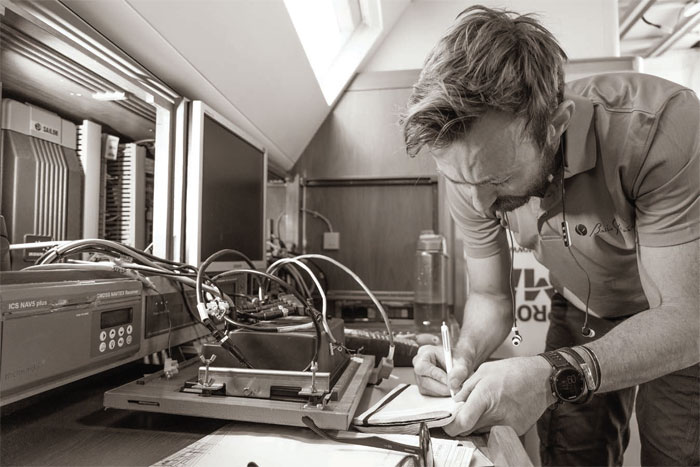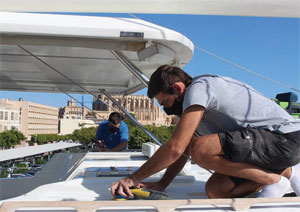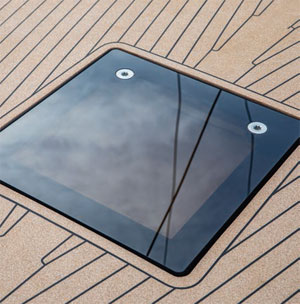

For many years they have been fastidiously creating some of the world’s finest yachts. One small drawback is that for many clients Baltic Yachts has always been rather a long way away geographically. Not any more...
There are big advantages to building yachts on the west coast of Finland. For the last 50 years it has been a centre of excellence where a talented workforce of shipwrights, joiners, composite builders and many other specialists produce some of the finest sailing yachts in the world, accumulating a vast pool of knowledge, experience and skills. There’s just one snag with the location – it’s a very long way, especially by sea, from the places where most owners choose to sail and keep their yachts. The solution for Baltic Yachts was to set up a service and refit hub in the epicentre of the Mediterranean yachting scene.
‘We started down here with warranty projects,’ says Matthew Lester, Baltic Yachts’ head of aftersales service who leads their steadily growing operation in Palma, Mallorca which is based in and around the STP shipyard in the heart of the city’s old harbour. ‘We were always coming here and we opened a workshop so we didn’t have to work out of our suitcases all of the time. And we were increasingly being asked to work on other boats. In 2014 we decided to staff the company here and we’ve never looked back.’
‘Every year there has been growth and we’ve taken on more and more service and refit work,’ he says. ‘It’s now 80 per cent of our business in Palma, with 20 per cent on the warranty side. We still work closely with Finland and have guys flying down, but we’ve cut that back a lot. We have a permanent workforce that covers carpentry, lamination, plumbing, mechanics, hydraulics, PLCs, electrics… all done by our people, managed by our project managers, with the same level of excellence that we have up north.’ The operation has expanded far beyond just servicing Baltic Yachts’ own fleet and now includes major refit work on many different brands and types of yachts.
Very few of the service team’s clients have their yachts based yearround in Palma but it’s their firstchoice location for refits and service work. ‘They migrate all over the world and wind up here in the pre-winter and post-Caribbean times, and also in the middle of summer,’ Lester explains. ‘The island is a draw and STP is situated very nicely. Crews really like to come here because we’re on the doorstep of the city centre and only five minutes from the airport.’ Baltic’s after-sales staff do still travel, of course, to wherever their services might be needed and some of their work each year is done in the Caribbean, but most of it is now concentrated in Palma.
One great benefit of having a permanent base in Mallorca has been the opportunity to build a very strong network of highly skilled and trusted, locally based subcontractors who have broadened the team’s client base as well as the range of services they offer. ‘Sometimes we’re asking them to help us but a lot of the time they’re asking us to help them,’ Lester says. ‘Without the relationships we have with our partners, we wouldn’t be able to operate here in the way that we do. For example last summer we pulled off a major refit of a 100ft Swan in just four months after it had been sitting idle for several years.’
Baltic Yachts’ Palma-based team has a proven ability to manage complex, large-scale projects. ‘A few years back we did a completely new interior for a Magnum 70 powerboat,’ Lester says. ‘It was manufactured up in Finland, sent down here and we did the full installation on site. We are constantly asking for small, medium and large things to be made in Finland and sent here for us to install. But we also make components here in our workshop almost every day. And it works both ways. When we have extra manpower here and they need help up there, we send our people to Finland.’

Above and below: Baltic Yachts’ service and refit operation is strategically located in and around the STP shipyard in the heart of Palma. The primary workshop is in the Global Building, the warehouse is in the North Dock building and the main office is just outside the port entrance, with further facilities on the outskirts of the city.

Adjustments to interior and exterior woodwork are a major part of the team’s work. ‘We converted a nav station into a bar recently,’ Lester says. ‘That was a good collaboration. Finland produced the cabinet and it was shipped down here, but because of the access size it was delivered in many pieces; we put it together on site and did the final fitting. Because we have such a good resource up north I don’t currently see us producing large cabinets here, but I do have carpenters with the skills do it.’
Composite expertise is of course one of Baltic Yachts’ great strengths, in Palma as well as in Pietersaari. ‘We have in-house structural knowledge that we can very quickly apply in the middle of a job if need be,’ Lester says. ‘Our composite guys are like fine carpenters, their work is a piece of art when it’s done, and it’s fully engineered with very close tolerances. They don’t necessarily need to have a full drawing, they just know what to do when they have something in front of them. Their work just sometimes gets overlooked because it gets painted over.’
Baltic Yachts’ composite know-how extends beyond carbon fibre, into the realm of alternative materials. ‘Back in the day there was advantage in using Kevlar in our hulls, now we see an advantage in using flax in different parts of the boat because it helps to absorb ambient noise,’ Lester says. ‘There’s a lot of that knowledge trickling through the company.’
One of their recent composite innovations is a new range of deck hatches, built in carbon fibre with glass or teak, and soon to be joined by a flax fibre variant. ‘We developed them after years of frustration, of not being able to get a good enough hatch,’ Lester says. ‘I saw a lot of that myself on the service side. We’re working with our colleagues in Finland and putting together packages for boats down here that are looking at replacing their hatches. When you change hatches you inevitably need to change some things on the carpentry side and alter the teak deck so we’re offering an inclusive deal.’

Future-proofing of older yachts is a significant part of the Palma team’s work. ‘The biggest trend right now is people buying secondhand boats and then wanting them to be reliable,’ Lester explains. ‘They want to be able to escape, to know that they can just go if they feel the need. We’re seeing that a lot.’
The innovation coming out of Baltic Yachts’ HQ in Finland stands the Palma team in good stead. ‘We know what’s coming out in new builds and that gives us an advantage,’ Lester says. ‘It means we can apply the engineering that has already been done on new builds to some of the older boats. A big shift to high voltage is happening in the industry and we’ve pushed one of our older boats from a conventional 24-volt system into a high-voltage system. The owner doesn’t really motor anywhere, he always sails the boat so he didn’t see the benefit in changing the propulsion. Where he sees the benefit is not running the diesel generators that often. So we upgraded the generators and switched out the entire battery system for a high-voltage battery bank. They can now run the generators for two hours and then operate on batteries for 12 hours.’
Another current trend is upgrading air conditioning systems, which have become much smaller and far more efficient in the last few years. ‘We see it as a great way to reclaim space inside engine rooms,’ Lester says. ‘The old units were the size of a pallet. The new ones are the size of a desktop computer and the weight is almost nothing. We have a project right now where we’ll be able to fit a sewage treatment plant as well as a new AC system in the same footprint of the old AC system, and in eco mode you can extend the quiet times on the vessel considerably.’
There is also a lot of interest in drive leg upgrades, from owners who see the obvious benefit in being able to regenerate electrical power via the propeller on ocean crossings. ‘Switching to 48V means you can sail across the Atlantic and not have to worry about how much diesel you are going to burn because you can regenerate the whole way,’ Lester explains. ‘After the recent installs on new builds that we’ve been doing in Finland, we are now looking at possibly offering a simple turn-key solution for 90ft to 110ft yachts. We haven’t put it together in a package just yet but we have all the knowledge to do that.’
Click here for more information on Baltic Yachts »
We invite you to read on and find out for yourself why Seahorse is the most highly-rated source in the world for anyone who is serious about their racing.
To read on simply SIGN up NOW
Take advantage of our very best subscription offer or order a single copy of this issue of Seahorse.
Online at:
www.seahorse.co.uk/shop and use the code TECH20
Or for iPad simply download the Seahorse App at the iTunes store


